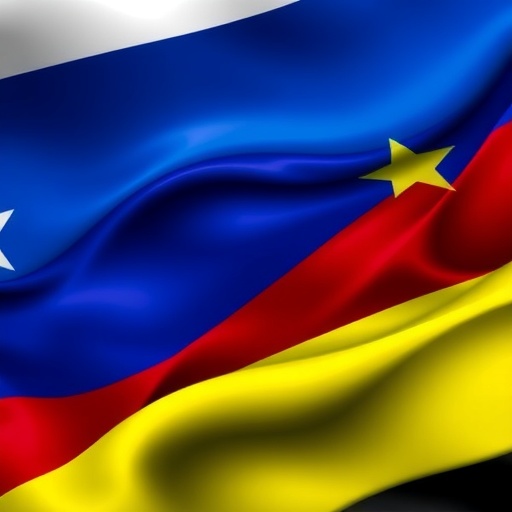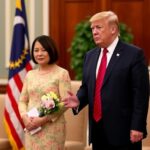US, Russia, and Ukraine Edge Closer to Diplomatic solution in Ukraine War as Trump-Putin Summit Looms
In a surprising development that has sent ripples through international diplomacy, Russian envoy Kirill Dmitriev announced that Russia, the US, and Ukraine are “quite close to a Diplomatic solution” to end the protracted three-year war in Ukraine. This revelation comes amid ongoing talks and speculation about a potential Trump-Putin summit, offering a glimmer of hope after years of stalemate and devastation.
- Kirill Dmitriev’s Revelation Ignites Diplomatic Buzz
- Backchannel Talks: Unpacking the Path to a Diplomatic Solution
- Trump-Putin Summit: Postponement Fuels Speculation on Timing
- Three-Year War’s Toll: Why a Diplomatic Solution Can’t Come Soon Enough
- Global Repercussions: What a Successful Diplomatic Solution Could Mean
Dmitriev, a key figure in Putin’s administration and head of Russia’s sovereign wealth fund, made the statement during a recent interview, emphasizing the progress in backchannel negotiations. “We are quite close to a Diplomatic solution,” he said, highlighting the involvement of all three major players: Russia, the US, and Ukraine. The envoy’s words mark a rare optimistic note from Moscow, contrasting with the entrenched positions that have defined the conflict since Russia’s full-scale invasion in February 2022.
The announcement arrives at a critical juncture, with the war having claimed tens of thousands of lives and displaced millions. According to United Nations estimates, over 10,000 civilians have been killed, and the economic toll on Ukraine alone exceeds $500 billion in damages. As global attention shifts toward potential peace efforts, questions abound about what this diplomatic solution might entail and whether it can truly bridge the deep divides.
Kirill Dmitriev’s Revelation Ignites Diplomatic Buzz
Kirill Dmitriev’s statement has quickly become the focal point of international media and diplomatic circles. As Putin’s personal envoy for special assignments, Dmitriev has been instrumental in fostering ties with Western counterparts, including during the early stages of the conflict. His role expanded significantly after the invasion, positioning him as a bridge between Moscow and Washington.
In the interview, Dmitriev elaborated on the nature of the talks, noting that they involve high-level discussions on territorial integrity, security guarantees, and reconstruction aid. “The conversations are productive, and all sides are showing willingness to compromise,” he added. This comes after months of quiet diplomacy, including virtual meetings between Russian officials and US intermediaries. Sources close to the negotiations, speaking on condition of anonymity, confirmed that Ukraine’s representatives have been actively engaged, with Kyiv expressing cautious optimism.
The envoy’s comments also touched on the humanitarian aspects, underscoring Russia’s interest in easing the suffering caused by the war. Dmitriev referenced recent prisoner exchanges and grain corridor agreements as building blocks for broader peace. However, he stopped short of detailing specifics, citing the sensitivity of ongoing deliberations. This opacity has fueled speculation, with analysts suggesting that economic sanctions relief for Russia could be a key bargaining chip.
From a historical perspective, Dmitriev’s involvement recalls earlier Minsk agreements, which aimed to resolve the Donbas conflict but ultimately failed. Yet, the current dynamics differ, with the US playing a more direct role under the incoming Trump administration. Dmitriev’s optimism is tempered by realism; he acknowledged that “challenges remain, but the momentum is there.”
Backchannel Talks: Unpacking the Path to a Diplomatic Solution
Behind the scenes, backchannel talks between Russia, the US, and Ukraine have intensified over the past several months, laying the groundwork for what could be a breakthrough diplomatic solution. These discussions, often mediated through neutral parties like Turkey or Qatar, have focused on core issues such as the status of Crimea, the demilitarization of eastern Ukraine, and NATO’s expansion eastward.
US officials have confirmed indirect involvement, with State Department spokespeople noting that “all options for peace are on the table.” In Ukraine, President Volodymyr Zelenskyy has publicly called for a “just peace,” while privately signaling flexibility on certain territorial concessions. A recent poll by the Kyiv International Institute of Sociology revealed that 62% of Ukrainians now support negotiations, up from 45% a year ago, reflecting war fatigue amid ongoing Russian advances in the east.
Key sticking points include Russia’s demand for recognition of annexed territories and Ukraine’s insistence on full sovereignty restoration. Economically, the talks have explored Russia’s reintegration into global markets, with the US hinting at phased sanctions relief tied to verifiable ceasefires. Dmitriev highlighted these elements, stating, “A diplomatic solution must be sustainable, benefiting all parties involved—Russia, the US, and Ukraine alike.”
Statistics underscore the urgency: The World Bank reports that Ukraine’s GDP has shrunk by 30% since the invasion, while Russia’s economy, bolstered by oil revenues, has shown resilience but faces long-term isolation. International aid to Ukraine has topped $200 billion, primarily from the US and EU, but donor fatigue is setting in. These pressures are pushing negotiators toward compromise, with experts like Fiona Hill, a former US National Security Council official, commenting, “The stars are aligning for a deal, but trust remains the biggest hurdle.”
Ulrich Speck, a senior fellow at the German Marshall Fund, added in a recent op-ed, “This diplomatic solution could redefine European security, but only if it addresses root causes like hybrid threats and energy dependencies.” The talks’ structure involves working groups on military de-escalation, humanitarian aid, and post-war reconstruction, with progress reportedly made in the latter two areas.
Trump-Putin Summit: Postponement Fuels Speculation on Timing
The postponed Trump-Putin summit remains a pivotal element in the quest for a diplomatic solution, with both leaders expressing intent to meet despite logistical hurdles. Initially slated for late 2023, the summit was delayed due to scheduling conflicts and escalating battlefield tensions, but insiders insist it is still on the horizon, potentially in early 2024.
Donald Trump, preparing for his second term, has repeatedly voiced a desire to end the Ukraine war swiftly, promising a resolution “in 24 hours” during his campaign. Putin, in response, has welcomed the overtures, viewing Trump as more amenable to Moscow’s positions than the Biden administration. The Trump-Putin summit could serve as a capstone to the ongoing negotiations, providing a high-profile platform to seal agreements.
Details of the postponement are murky, but sources indicate that security concerns and the need for preliminary accords played a role. “The summit will happen when the time is right,” Dmitriev affirmed, linking it directly to the broader diplomatic solution involving Russia, the US, and Ukraine. Preparatory meetings have included Trump’s team engaging with Russian diplomats in neutral locations like Vienna.
Historical precedents, such as the 2018 Helsinki summit between Trump and Putin, suggest that such encounters can yield symbolic progress, even if substantive outcomes vary. Analysts warn, however, of potential pitfalls: A rushed deal under Trump could alienate European allies, who have committed over €100 billion in support to Ukraine. NATO Secretary General Jens Stoltenberg recently stated, “Any diplomatic solution must uphold international law and Ukraine’s right to self-determination.”
Public reaction to the Trump-Putin summit prospect is mixed. In the US, a Pew Research Center survey shows 55% of Americans favor diplomatic efforts, while in Russia, state media has portrayed it as a victory for Putin’s strategy. For Ukraine, the summit represents both opportunity and risk, with Zelenskyy emphasizing, “We will not accept a dictated peace.”
Three-Year War’s Toll: Why a Diplomatic Solution Can’t Come Soon Enough
The three-year war has exacted a devastating toll, making the pursuit of a diplomatic solution not just desirable but imperative. Launched on February 24, 2022, Russia’s invasion caught the world off guard, leading to widespread condemnation and unprecedented sanctions. Ukraine’s fierce resistance, aided by Western arms, has prevented a quick Russian victory but prolonged the agony.
Casualties are staggering: Ukrainian officials report over 500,000 military personnel wounded or killed on both sides, though independent verifications are challenging. Civilian infrastructure—schools, hospitals, energy grids—has been ravaged, with satellite imagery from the UN showing destruction across 20% of Ukraine’s territory. The refugee crisis has seen 6 million Ukrainians flee abroad, the largest in Europe since World War II.
Economically, the war has disrupted global food and energy supplies. Ukraine, a breadbasket of Europe, saw its wheat exports plummet by 50%, contributing to a 20% rise in global food prices in 2022. Russia’s pivot to Asia has mitigated some impacts, but Western sanctions have frozen $300 billion in Russian assets, crippling its financial sector.
Human stories amplify the urgency. In Kharkiv, families huddle in bomb shelters; in Donetsk, children attend classes amid ruins. Quotes from the front lines, like that of Ukrainian soldier Andriy Melnyk, “We fight for our homes, but peace is what we crave,” resonate globally. International organizations, including the Red Cross, have delivered $4 billion in aid, yet needs far outstrip supplies.
The war’s geopolitical ripple effects are profound, straining US-Russia relations to Cold War lows and testing alliances. China’s tacit support for Russia and Iran’s drone supplies have complicated dynamics, while the US’s $60 billion in military aid to Ukraine has sparked domestic debates on priorities.
Global Repercussions: What a Successful Diplomatic Solution Could Mean
A successful diplomatic solution involving Russia, the US, and Ukraine could reshape the global order, offering pathways to stability while posing risks of uneven implementation. In the short term, it might halt hostilities, enabling the return of displaced persons and kickstarting reconstruction estimated at $400 billion by the EU.
Longer-term implications include a reevaluation of NATO’s role, potentially leading to new security architectures in Eastern Europe. For Russia, reintegration could ease economic pressures, boosting trade with the West and stabilizing the ruble, which has fluctuated wildly since 2022. The US stands to redirect resources from Ukraine aid to domestic needs, aligning with Trump’s “America First” agenda.
Ukraine’s future hinges on robust guarantees; a neutral status or EU accession fast-track could emerge as incentives. Experts like Michael Kofman from the Carnegie Endowment predict, “This diplomatic solution, if achieved via the Trump-Putin summit, might prevent escalation but requires multilateral buy-in to endure.”
Challenges persist: Hardliners in Moscow and Kyiv could sabotage deals, and monitoring mechanisms would be essential. The International Criminal Court’s arrest warrant for Putin adds legal complexities. Yet, the potential for peace is transformative—reduced nuclear risks, normalized energy flows, and a precedent for resolving frozen conflicts.
Looking ahead, the international community watches closely. The UN Security Council could convene post-summit to endorse agreements, while G7 nations pledge reconstruction funds. As Dmitriev noted, “The diplomatic solution is within reach; now it’s about seizing the moment.” With talks progressing and the Trump-Putin summit on the calendar, the world edges toward what could be a historic turning point in the Ukraine war.









